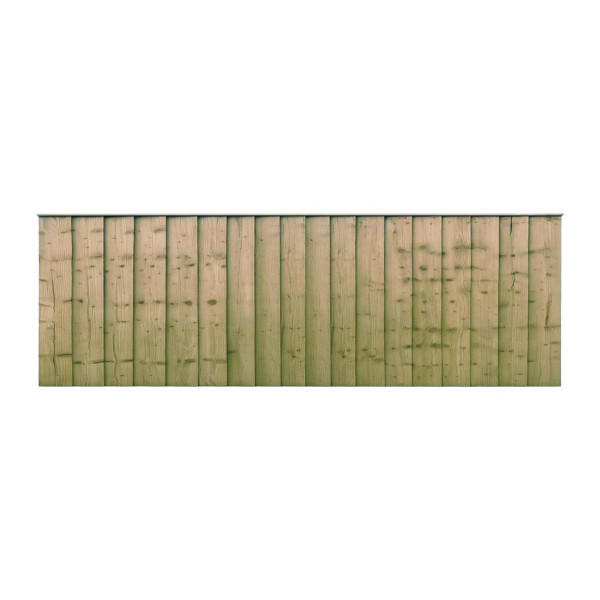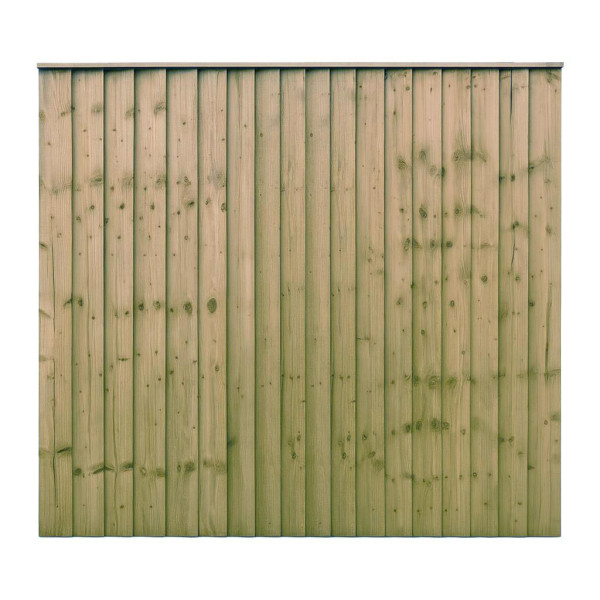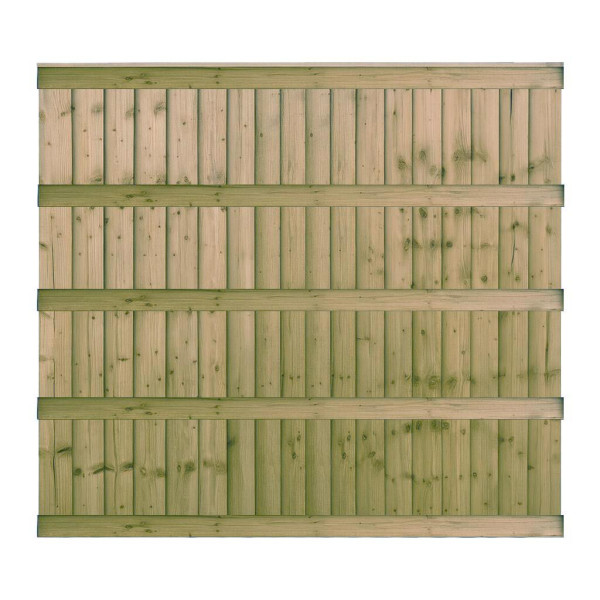Closeboard Fence Panels
Buy Closeboard Fence Panels for Maximum Privacy, Strength and a Calm Skyline
If you want a boundary that looks smart, feels secure and stands up to British weather, closeboard fence panels are the proven choice. Built with dense, vertically overlapped boards on robust rails, they deliver immediate privacy, reassuring stiffness and quieter gardens in wind—ideal for overlooked patios, busy side returns and long back boundaries. At East Coast Fencing, our closeboard range is pressure‑treated and sized for straightforward planning around standard bay centres, so you can set out clean lines, install with confidence and enjoy a fence that behaves well in day‑to‑day life. Choose the specification that suits your plot, match it with compatible posts, base protection and capping, and check out with confidence—free delivery applies on orders £99+.
Why closeboard fence panels earn their place in British gardens
Closeboard is all about dependable privacy and structural calm. The vertical cladding sheds water down the face and locks sightlines at everyday distances; the heavier rails resist racking so the skyline stays level; and the weight helps dampen the little rattles and creaks that lighter options struggle with. If storms nudged your old boundary out of true, or you simply want a fence that feels solid the first night it’s up, closeboard is a practical upgrade that still reads timeless from the house and the street.
How closeboard compares—privacy and presence without fuss
Overlap and traditional lap styles are great value for long refresh projects; slatted and hit‑and‑miss designs trade a little privacy for airflow and a contemporary look. Closeboard sits in the “maximum privacy with a composed silhouette” camp: stronger screening, a quieter feel in gusts and robust construction that pairs naturally with protective base boards and a tidy capping rail. If your priority is a secure, low‑drama boundary that works hard in real life, you’ll likely end up here.
Pick your specification: heavy duty or ultra heavy duty
Not every plot faces the same demands. For most exposed gardens and family spaces, our heavy duty closeboard fence panels have the mass, rail strength and fitted capping to feel calm in wind and deliver long service. On hilltop or particularly weather‑beaten sites, stepping up to ultra heavy duty closeboard fence panels adds extra stiffness and weight across the panel, helping long runs stay quieter in gusty corridors and around corners where load concentrates. Either way, consistent stock, tidy fixings and disciplined joinery are your visual cues to a professional, long‑lived result.
Heights, widths and planning your run
Closeboard panels are built for \~1.83 m centres, keeping layout quick and accurate. Heights range from modest dividers to full privacy screens; on sloping ground, decide early whether you’ll step (crisp, rhythmic levels) or rake (continuous sweep)—both approaches look excellent if you commit and keep your base datum consistent. On very exposed plots, shorten bay centres slightly or increase post section to lower bending moments and keep the skyline composed. Corner posts set the line visually and structurally; land them dead plumb and carry rail heights through the turn so your eye reads one continuous design.
Build the whole system, not just the panel
Closeboard panels do their best work when they’re supported by reliable posts and protected at the base. For maintenance‑light straightness and easy future swaps, slotted concrete fence posts make assembly repeatable: seat a board, slide a panel, pack level, move on. Prefer a warm, all‑timber look and easier on‑site tweaks? wooden fence posts are the installer’s friend—simple to notch, trim and fine‑tune for tricky corners and height changes. At ground level, a protective plinth reduces splashback and strimmer rash; on high‑traffic side passages and damp soils, many installers choose concrete gravel boards for belt‑and‑braces durability, while timber boards keep a continuous wooden tone for cottage schemes and planted borders. Above, a neat capping rail ties the skyline, sheds water away from vulnerable board ends and hides tiny height variations panel to panel—our panel capping profiles make that finish easy.
Setting out for straight, quiet results
Start with the posts that matter most: corners, ends and any gate reveals. Pull a taut string at final top height (and at rail datum if you’re building onto existing work) and let that line discipline the run. Form sound footings; on softer ground, tamp a granular base for drainage and stability before you pour. With slotted posts, confirm slot height against your board/panel stack before the mix cures; with timber posts, pre‑drill near edges and fix panels with exterior‑grade screws, seating heads flush rather than crushing fibres. Keep a small ground gap beneath cladding for airflow and easier mowing; it does more for appearance and longevity than you’d think.
Wind, privacy and neighbourly comfort
Closeboard’s party trick is immediate privacy at everyday heights. Where wind exposure is severe, consider blending a few semi‑open bays elsewhere on the boundary—say along a side return—so overall pressure drops while your main seating area keeps its solid, calm backdrop. A taller base board tightens ground gaps (useful for small dogs) and reduces mower and strimmer scuffs in high‑use corridors. At the street side, maintaining a level top line between neighbours reassures everyone the boundary is intentional and fair.
Detailing that elevates the finish
Small choices add up. Align screw rows for a tidy presentation and fewer squeaks; keep joint lines centred over posts; and repeat cap shapes and stains consistently across the run. Where the line meets an entrance, carry your closeboard language through the access point with a simple boarded gate, or contrast gently with a lighter pattern near the threshold—either way, land the change at a logical transition so it reads designed, not improvised. On patios and decks where digging is impractical, bolt‑down shoes can hold short decorative screens; for full‑height closeboard, concrete‑in remains the gold standard.
Finish and colour—coordinate with hard landscaping
Pressure‑treated timber in brown or green can be left to mellow naturally; darker stains modernise instantly and make planting pop; lighter tints brighten narrow side returns and small courtyards. Repeat your chosen tone across posts and capping, and the fence reads as one composed element rather than a collection of parts. Behind architectural planting—grasses, olives, clipped evergreens—the vertical grain of closeboard creates a calm, textured backdrop that frames foliage without stealing attention.
Installation pointers from the trade
Make early decisions on step heights or rake so you’re not chasing corrections bay by bay. Offer panels up dry to confirm centres before fixing; pack level with purpose‑made shims rather than improvised wedges that trap water and buzz in wind. Finish footing tops with a slight fall away from timber to shed rain, and don’t bury post faces under mulch—airflow is your friend. If the boundary curves, faceted straight runs between tight posts often look crisper and perform better than forced bends.
Care that fits real life
Low‑effort habits keep closeboard looking its best. Brush away leaf litter from rails each autumn, keep soil and mulch below the gravel board line and avoid harsh jet‑washing near joints—it can drive water where you don’t want it and lift fibres. Inspect fixings every spring, tighten lightly and refresh breathable finishes when needed. If you make alterations—adding a trellis band, trimming around services—seal any fresh cuts before refitting so end grain stays protected.
Working with slopes, steps and corners
On sloping plots, stepping panels usually reads cleanest; keep step increments regular and choose longer posts at step points to maintain embedment. With raked tops, maintain a consistent reveal at the skyline or under a capping rail so the rhythm stays deliberate. At corners, carry rail heights through and reinforce junctions; on internal corners, leave room for vegetation and downpipes so future maintenance doesn’t fight the fence.
Design ideas that make closeboard feel bespoke
Use full‑height closeboard behind a dining terrace for a quiet, comfortable room‑outside; transition to a lighter language near the kitchen door with a short run of open trellis above a few bays to bring back light and breeze. Anchor a garden office with a closeboard backdrop stained deep brown or charcoal so the structure feels grounded and planting can take the spotlight. On long boundaries, repeat a composed sequence—panel, panel, feature moment, panel—to avoid visual monotony and to signal intended “beats” along the run.
Quick buyer’s checklist for smoother installs
- Choose the right spec: heavy duty closeboard for most exposed plots; step up to ultra heavy duty when you want maximum stiffness and calm.
- Match posts to the job: low‑maintenance straight lines with concrete posts, or a warm all‑timber look with wooden posts.
- Protect the base: add a durable plinth—many installers choose concrete gravel boards for high‑wear sections—and keep the base datum consistent.
- Finish the skyline: fit tidy panel capping for clean runoff and a unified top line.
Order closeboard fence panels today
Pick the specification that suits your exposure and privacy goals, select posts and base boards that complete the system, and install to a clear datum for straight, quiet lines. With closeboard fence panels from East Coast Fencing you get the dependable privacy, strength and long‑lived good looks that make gardens easier to live with—supported by free delivery on orders £99+.
We also supply closeboard fence panels in wholesale quantities through our dedicated stockist portal, GardenFencingSupplies.co.uk, making it easy for merchants and stockists to browse, order, and manage their fencing requirements online.






